Chinese Sword Guard: Its Types, Characteristics, and History
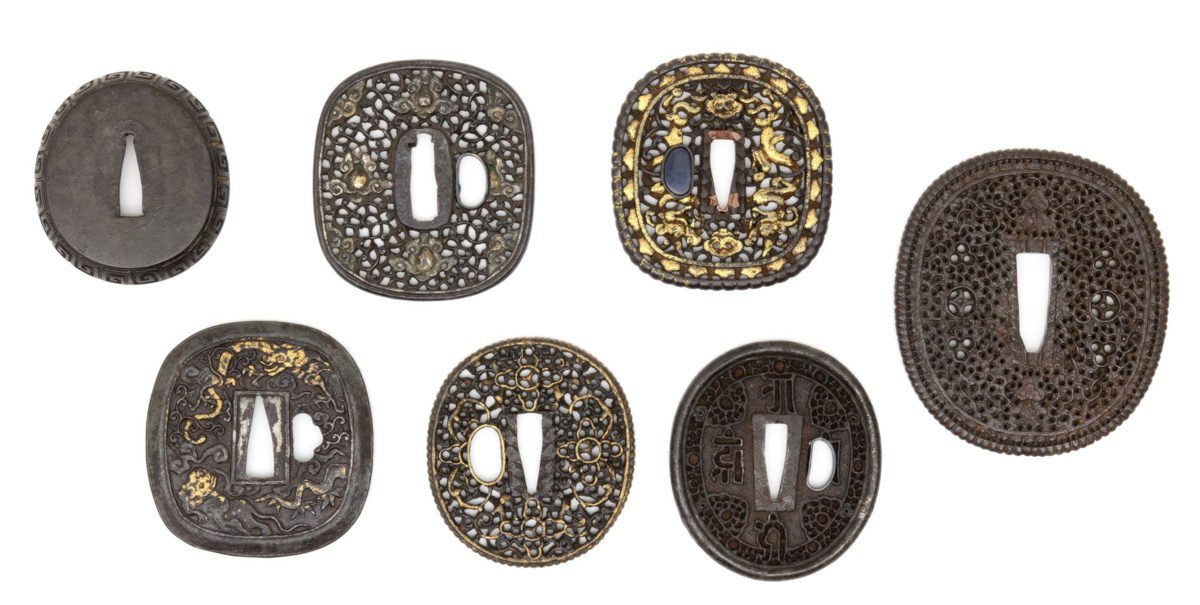
What’s in this article?
Chinese sword guards greatly varied in form and design. Some were made for full-scale battles, while others were only functional for occasional self-defense. They also represent the most complex metalwork made in China at the time and feature influences from several cultures.
Let’s explore the different types of Chinese sword guards, from the most popular to the rarest ones, and their history.
Types of Chinese Sword Guards
In Chinese texts, sword guards are referred to as hūshǒu (護手). The saber handguard is called dāo hūshǒu (刀護手), which often implies the disc guards during the Qing dynasty. The Chinese straight sword jian (劍) also has a small sword guard and is rarely equipped with disc guards. Collectors use various terminologies to describe Chinese sword guards. Here are some of them:
1. Backward Swept Guards

Backward-swept guards are commonly seen on Chinese straight swords. They are often carved with zoomorphic designs or engraved with Chinese symbols. The most popular types are the tāotiè and fúshòu. The ace-of-spade guard is the most commonly used in martial arts.
“Ace of Spades” Guard
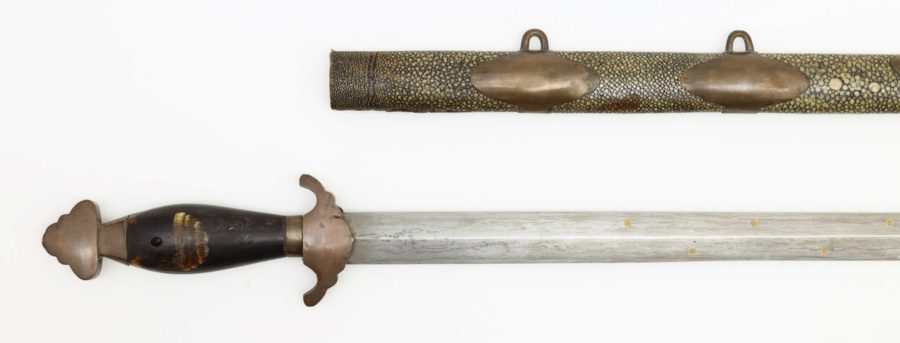
The ace-of-spade form is the typical sword guard of jian from the late Qing dynasty to the early Republican period. It is often plain but sometimes decorated with engravings. During the Republican period, from 1912 to 1949, many Chinese martial arts moved away from practicality in warfare into forms of practice that we know today. Swords, including jian with this ace-of-spade guard, were widely used in martial arts training.
Tāotiè-Form Guard

Many sword guards of the Chinese straight sword jian (劍) have a zoomorphic design cast in a tāotiè (饕餮) form. In Chinese folklore, a tāotiè is a greedy monster who devours its own body and serves as a reminder against self-indulgence.
A tāotiè, meaning gluttonous, is commonly seen on Chinese sword guards and other objects. Generally, its curling hair serves as the quillons or arms of the handguard. Tāotiè guards are also seen in the double straight swords shuangjian (雙劍).
Fushou-Type Guard

The fushou-type sword guard features bats and stylized longevity symbols. In Chinese, the word for bat is fu, a homonym of 福, meaning blessing; good fortune; happiness; prosperity. On the other hand, shòu (壽) is the character for longevity.
Hence, fúshòu (福壽) means a long and blessed life. The fushou-type sword guard often matches the rest of the sword fittings. It is commonly found on the straight sword jian (劍), which the scholarly elite used as a status symbol and self-defense weapon.
2. Hùshǒu pán (Disc Handguard)
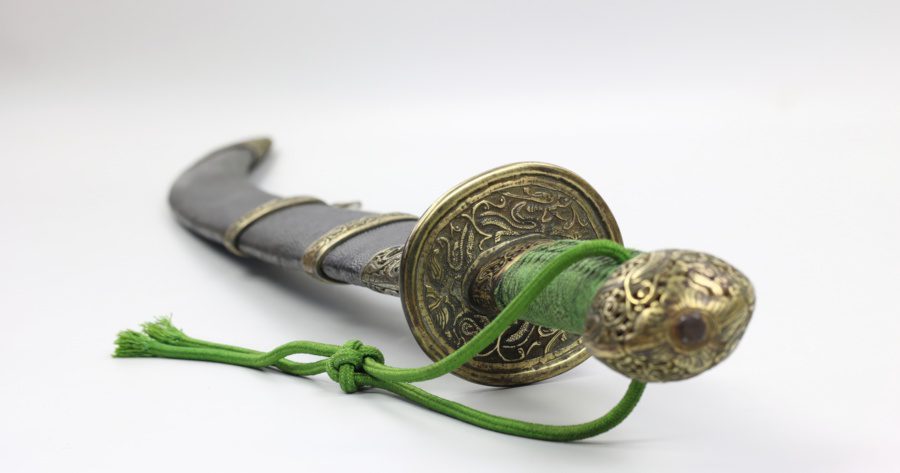
Hùshǒu pán (護手盤) translates as hand protecting disc. It generally refers to disc guards found on Chinese military sabers and occasionally on straight swords and polearms. However, it widely varies from plain and utilitarian to carved and openwork designs.
Disc handguards were more common on earlier jian swords of the Ming and early Qing and became obsolete by the late Qing. On the other hand, the Chinese long sabers of the Qing dynasty often had disc guards.
3. Cup Guard

Some Chinese sword guards have a cup-like design, from rounded to quatrefoil shapes. Some also feature ornamental designs and Chinese auspicious symbols inside the cup. They often equipped dress sabers for going out and about. Generally, they are light enough to be worn comfortably yet sturdy enough to function well in a civilian self-defense environment.
4. D-Shaped Guard

The D-shaped guards are common on the butterfly swords called húdiédāo (蝴蝶刀), which typically fit in a single scabbard. In southern Chinese martial arts, these swords are known as ba zhan dao (八斬刀), meaning eight cutting knives. These twin swords are also equipped with half-hilts to be drawn as if they were one weapon.
D-shaped guards provide great hand protection and can be utilized for up-close punching, similar to a knuckle duster. In the 19th century, the húdiédāo was used by the military, local militia, and Chinese gang members. It remains popular in Chinese martial arts, especially in Wing Chun, Choi Li Fut, and Hung Gar.
5. S-Shaped Guard

The heavy S-shaped guard provides protection while counterbalancing a heavy blade. It is typically found on large dadao with a wide clipped tip. A Republican-period dadao served as an executioner’s sword, though any sword may serve the purpose. They also served as cutting weapons and training swords used by martial artists.
6. Half-Round Guards

Some double sabers called shuangdao (雙刀) have half-round guards to fit into a scabbard side-by-side. Chinese soldiers wielded the two sabers, allowing parrying and striking simultaneously. In the Qing military, these sabers were issued to the Green Standard Army, which had an internal peacekeeping and supporting role in front-line warfare.
7. Ram’s Horn Guard

A ram’s horn guard is commonly seen on the chopping saber kandao, dadao, spearheads, and rarely on jian. Militiamen in rural Chinese villages commonly used straight swords with this type of guard. The leadership over these militias was in the hands of the local upper classes, scholars, and literary elite who used jian. Hence, the jian also served as a militia weapon in times of rebellion.
8. Circular Guard
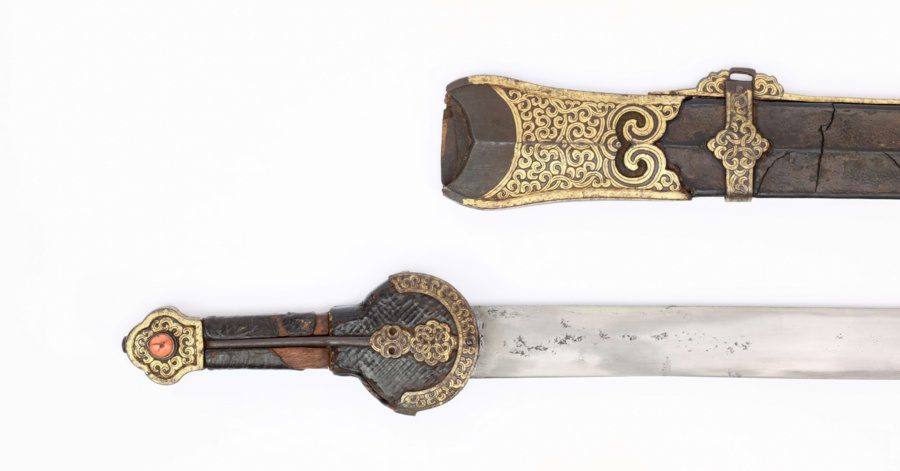
The circular guard is among the rarest types of Chinese sword guards. The scabbard’s mouthpiece complements the circular guard when sheathed. It is found on swords from the Tibet or Sichuan border regions.
During the Qing dynasty, the western Sichuan regions were led by local kings called tǔsī (土司), who the imperial government recognized. In the 18th century, these swords were likely presented by the local kings to the Qianlong emperor.
9. Crescent Moon Guard

The crescent moon guard is among the oldest handguards found on Chinese swords. It was the most widespread type from the Five Dynasties to the Song Dynasty, used for all single-edged and double-edged swords. Some were rounded, resembling a crescent moon, while others had a ridge in the middle.
Crescent sword guards are depicted on stone statues and paintings; rare examples survive. They also appeared in Tibetan regions and were probably introduced in the Yuan dynasty. However, they eventually declined as zoomorphic guards emerged.
Characteristics of Chinese Sword Guards
A sword guard is mounted between the grip and blade to protect the user’s hand. Chinese sword guards widely varied in their design. Some were strictly utilitarian, while others were both functional and decorative.
Here are the unique characteristics of Chinese sword guards:
Metal and Construction
Early sword guards were made of forged or cast iron, but by the 19th century, cast brass mounts became common, and sword guards along with other mountings often had matching designs. However, sword guards varied from simple iron plates to ornamental discs.
Some Chinese-style sword guards exported to Japan were made from shakudo—a copper alloy with small amounts of gold—widely used in Japan and Vietnam. It gives the sword guard a deep, dark blue or black color.
Shape and Design
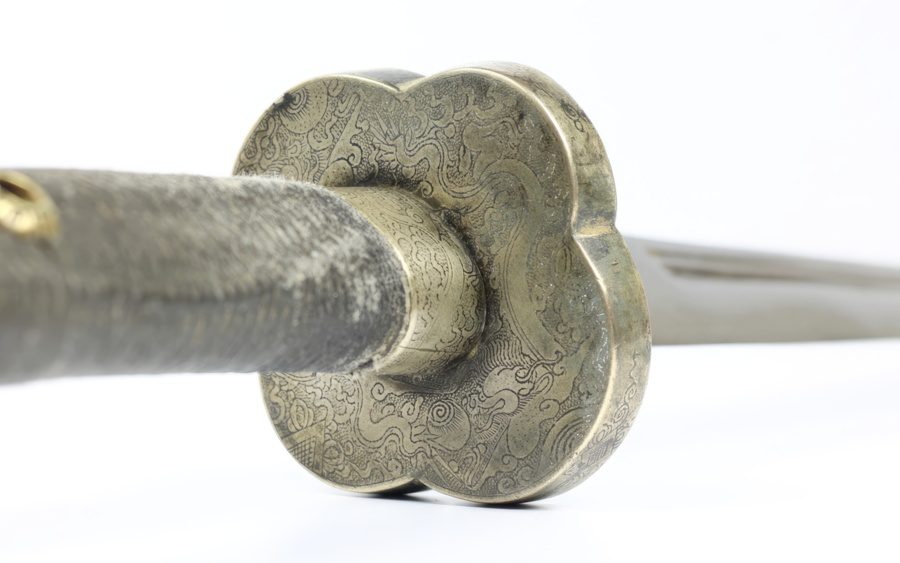
Most Chinese sword guards are disc-shaped, while others have quatrefoil and ace-of-spade shapes. Military sabers generally have rounded guards, but the straight sword jian could also be equipped with a disc guard. Some can also be found in a stylized coin shape.

Chinese sword guards have an opening for the tang, usually angular instead of oval. Some Chinese makers produced sword guards that fit both Chinese and Japanese swords. Some have the hitsu-ana openings found on a Japanese sword guard for a knife and a pin carried with the sword.

Some Chinese sword guards also come with a collar called tūnkǒu (吞口), meaning swallowing mouth. It is commonly found on the base of the polearm blade or saber blade beneath the sword guard and rarely on straight swords.
Craftsmanship

In the Qing dynasty military, soldiers’ sabers often had plain brass sword guards and fittings. On the other hand, Chinese officer’s sabers were decorated, often engraved or with pierced openwork designs.
Openwork or Filigree Designs
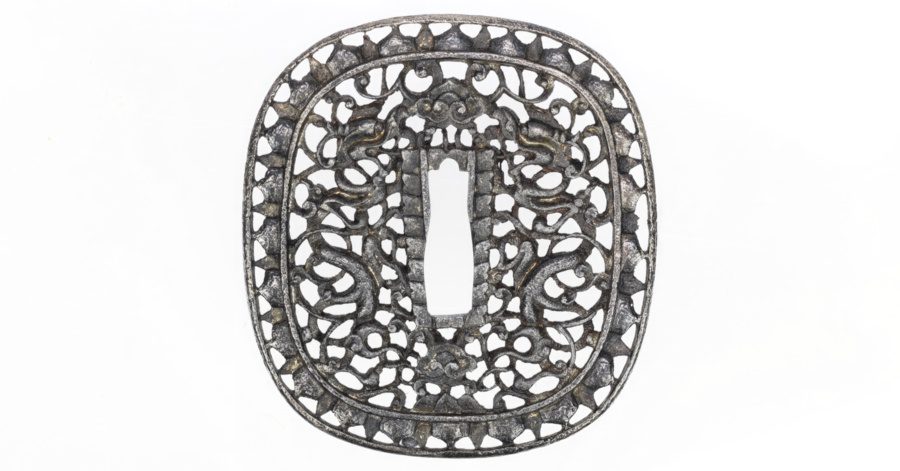
Many sword guards made for a Chinese saber had an openwork design called lòukōng (鏤空). These loukong panhushou (鏤空盼護手), translated as openwork disc type hand guard, were deeply chiseled and pierced. However, only a few Chinese sword guards with an openwork style survived due to their threadlike design that often rusted away.
Ornamentation and Symbols
Sword guards and other fittings often feature Chinese motifs, such as dragons, phoenixes, swastikas, auspicious symbols, and so on. Some were carved or engraved with zoomorphic designs, from bats to tāotiè, and longevity symbols, such as shòu (壽).
Some 18th-century sword guards had ornamentations commonly seen in ancient Chinese bronzes. The Qianlong emperor was an avid collector of archaic bronzes and had their stylistic motifs incorporated into newly made swords and other weapons.
Facts About the Chinese Sword Guards
Chinese sword guards served as status symbols for the princely noble ranks. Some rare types were also preserved in Japan where they are treasured by sword owners and collectors. These Chinese sword guards generally blended Chinese and Japanese aesthetics and function.
Utilitarian sword guards were popular among rebels during social unrest.

Chinese sabers with plain sword guards were functional and practical weapons in times of chaos. The rebels and their enemies used them during times of social unrest, from before the outbreak of the Boxer Rebellion to the Warlord period of the early 20th century.
Chinese sabers with angular-style fitting often had rounded sword guards.

During the Ming and Qing dynasties, the standard waist-worn saber of the military and presentation sabers often had an angular style fitting called fangshi. The fangshi mounting had an angular handle and scabbard. Still, sabers in this mounting often retained their disc guards. By the 19th century, a rounded style fitting became widespread among Qing officers and ordinary soldiers.
Chinese sword guards with precious stones were reserved for higher noble ranks.
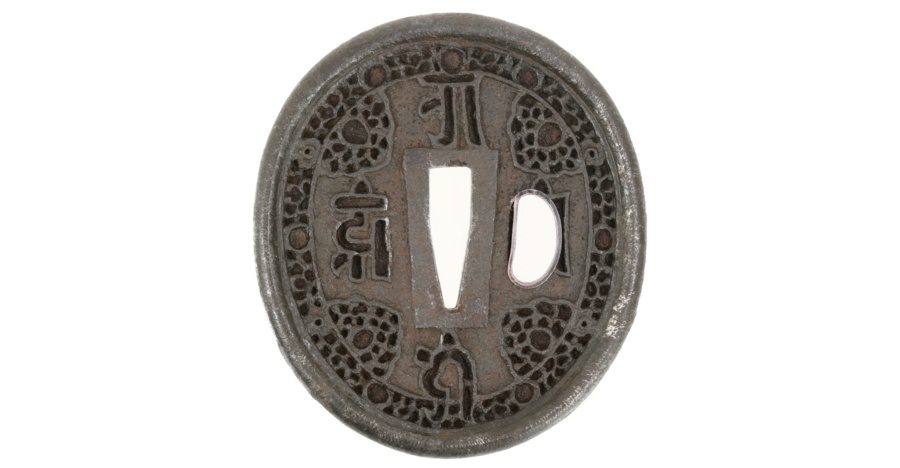
Simple sword guards and mountings reduced the cost of production. Lower-ranking officers of the Qing dynasty used simple sword guards, usually engraved instead of having fancy openwork designs. On the other hand, princely ranks could decorate their sabers with pearls, coral, turquoise, lapis lazuli, and such. Surviving sword guards with several bezels likely once held these semi-precious stones.
Larger types of Chinese sword guards were designed for two-handed sabers.

The Chinese emperor and imperial guards wore yidao (義刀), meaning virtuous saber. It was a large type of two-handed saber that required a larger sword guard. An honor guard accompanying the imperial chariot also wore the saber. Some of these large sword guards also held precious stones restricted to princes and higher ranks.
It was common to re-hilt old blades, resulting in unusual sword guard and grip combinations.
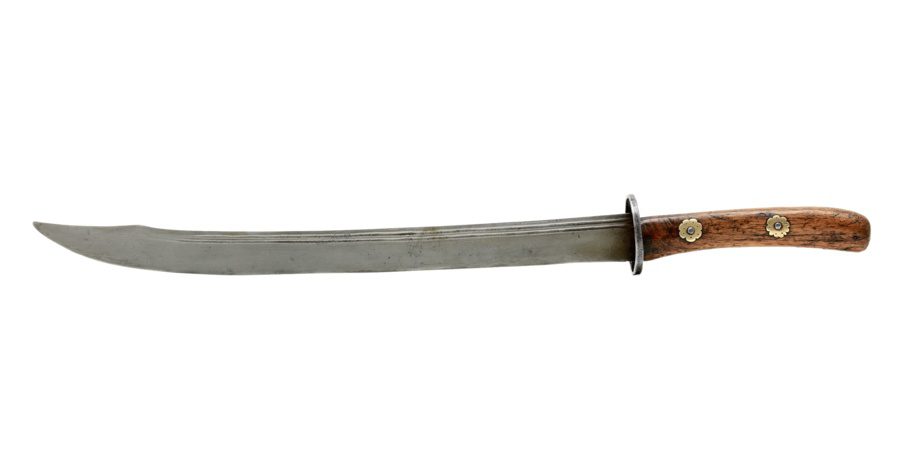
Many old blades were shortened and mounted in a locally preferred hilt style throughout their lifetime. Hence, some Chinese swords have unusual designs. A forged iron guard with a raised rim was typical for a Chinese saber. However, the hilt construction with a grip consisting of two slabs of wood riveted to the tang was more common in some Vietnamese polearms.
Some Chinese sword guards were heavily inspired by Japanese design.

In the 16th century, when China fought the wokou or Japanese pirates, the Chinese also used sabers inspired by the Japanese design. The Chinese had various names for their long sabers, such as chángdāo (長刀), wōdāo (倭刀), and so on. Some long sabers feature strong Japanese designs as seen on the sword guards, blades, and hilt.
The Chinese also produced sword guards to be exported to Japan.
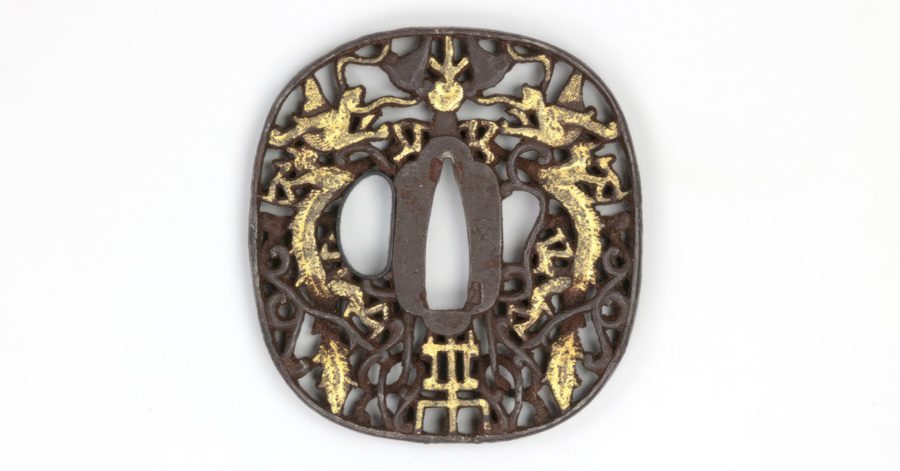
Some sword guards with a Chinese-Tibetan style were made for export to Japan. They could be distinguished by their hitsu-ana openings on both sides of the tang opening. Generally, these openings accommodate the kozuka, a utility knife handle, and kogai, a pin-like accessory. However, the Japanese also produced their sword guards with strong Chinese influence.
Japanese sword guards with Chinese or foreign influence are called nanban tsuba.
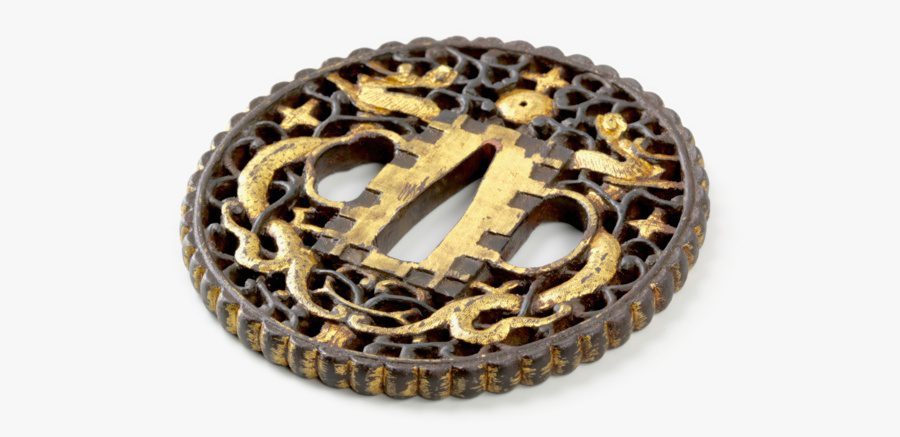
The Japanese sword guard is called tsuba in Japanese, and the term nanban tsuba literally means Southern barbarian sword guards. Many collectors are unaware that many nanban tsuba are not just foreign-influenced—but entirely foreign. Many of these were not just Chinese in style but of Chinese manufacture and adjusted for Japanese swords.
Such sword guards entered Japan through maritime trade with the Chinese and the Dutch and gift exchanges. Still, some Japanese craftsmen made nanban tsuba inspired by Chinese or foreign styles to make it look like an exotic import.
Asian export sword guards from China and Vietnam have similar features.
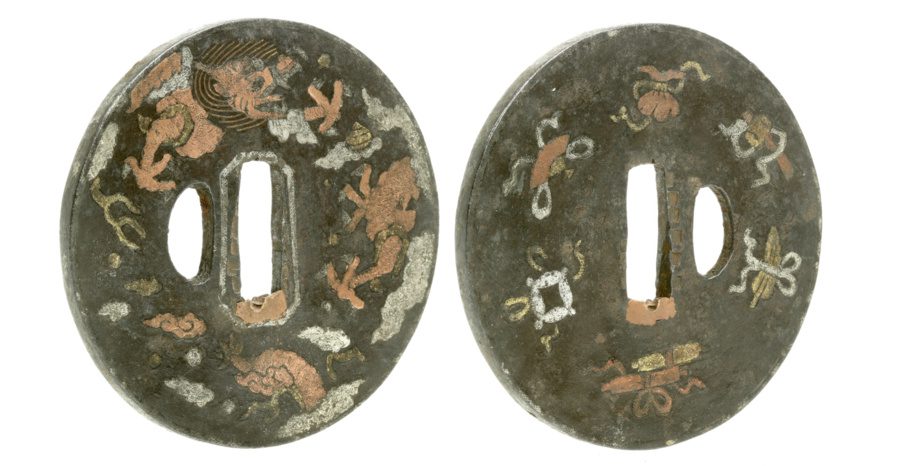
These sword guards are similar in large round discs and overlay decorations, often in a combination of brass, copper, silver, and gold. The ornaments also feature Chinese auspicious symbols, such as dragons, phoenixes, and objects associated with Taoist immortals. Vietnamese sword guards also featured an elongated outline around the tang opening, often implying the handle cross-section on the Chinese and Japanese guards.
History of Chinese Sword Guards
In the 17th century, Chinese sword guards had various designs, often with elements from several cultures. Some were imported sword guards from other cultures inspired by Chinese design or altered to be used on Japanese swords.
Influence of Tibetan Saddles to Chinese Sword Guards

Tibetan saddles inspired many Chinese sword guards with an openwork design. Since these guards are very Tibetan in design, they are often called Sino-Tibetan. However, Tibetans never used swords that required this type of handguard.
These openwork sword guards were first seen among the Manchu aristocracy. Many believe the early Manchus and Mongols had religious ties with the Tibetans, and many converted to Tibetan Buddhism.
In the 17th century, the Mongols, developing their alliances with the Manchus, gave carved saddles to the Manchus as tribute. These were probably the Tibetan saddles with pierced ironwork from Tibet. The Manchus likely wanted sword mounts to match their saddle design.
Chinese and Asian Export Sword Guards

Several Asian export sword guards, including Japanese tsuba inspired by them, were modeled after the Chinese sword guards. In the 17th and 18th centuries, Chinese sword guards were imported to Japan and called Canton-gata or Canton-form tsuba, named after the port they seemed to come from. However, these pieces originated in Beijing and Shenyang.
Some Asian export sword guards were also designed for the Japanese market and usually featured a hitsu-ana opening for the utility knife carried in the same scabbard as the sword. Some sword guards, especially those that were finely carved, were made in Sri Lanka and probably custom-made to be taken to Japan as gifts.
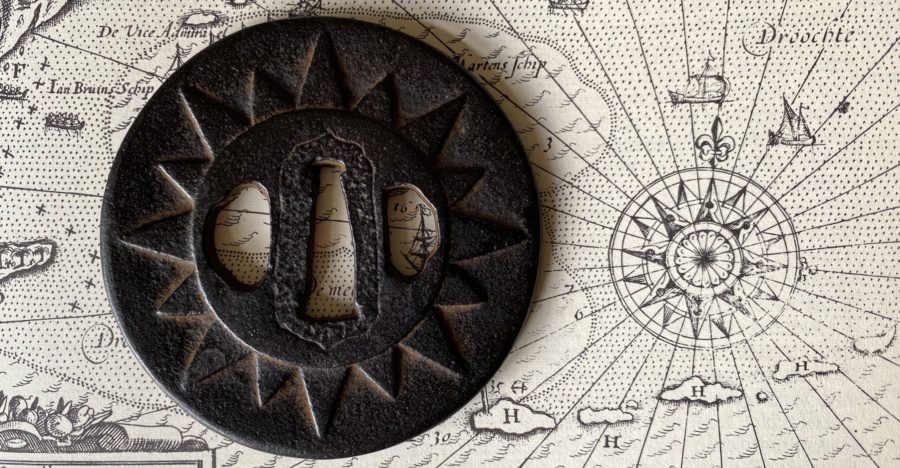
Some sword guards originated in Southern China and featured European motifs, such as a compass rose commonly seen on European maritime maps. Chinese makers active during the maritime trade across Asia likely produced them. Still, they retained the overall shape and form of Chinese sword guards.
Conclusion
Chinese sword guards greatly varied in their shapes and craftsmanship. Some were also altered to be used on a Japanese sword. Due to their historical value and craftsmanship, Chinese sword guards remain the object of interest among individuals who collect swords, colonial antiques, and Asian arms.




